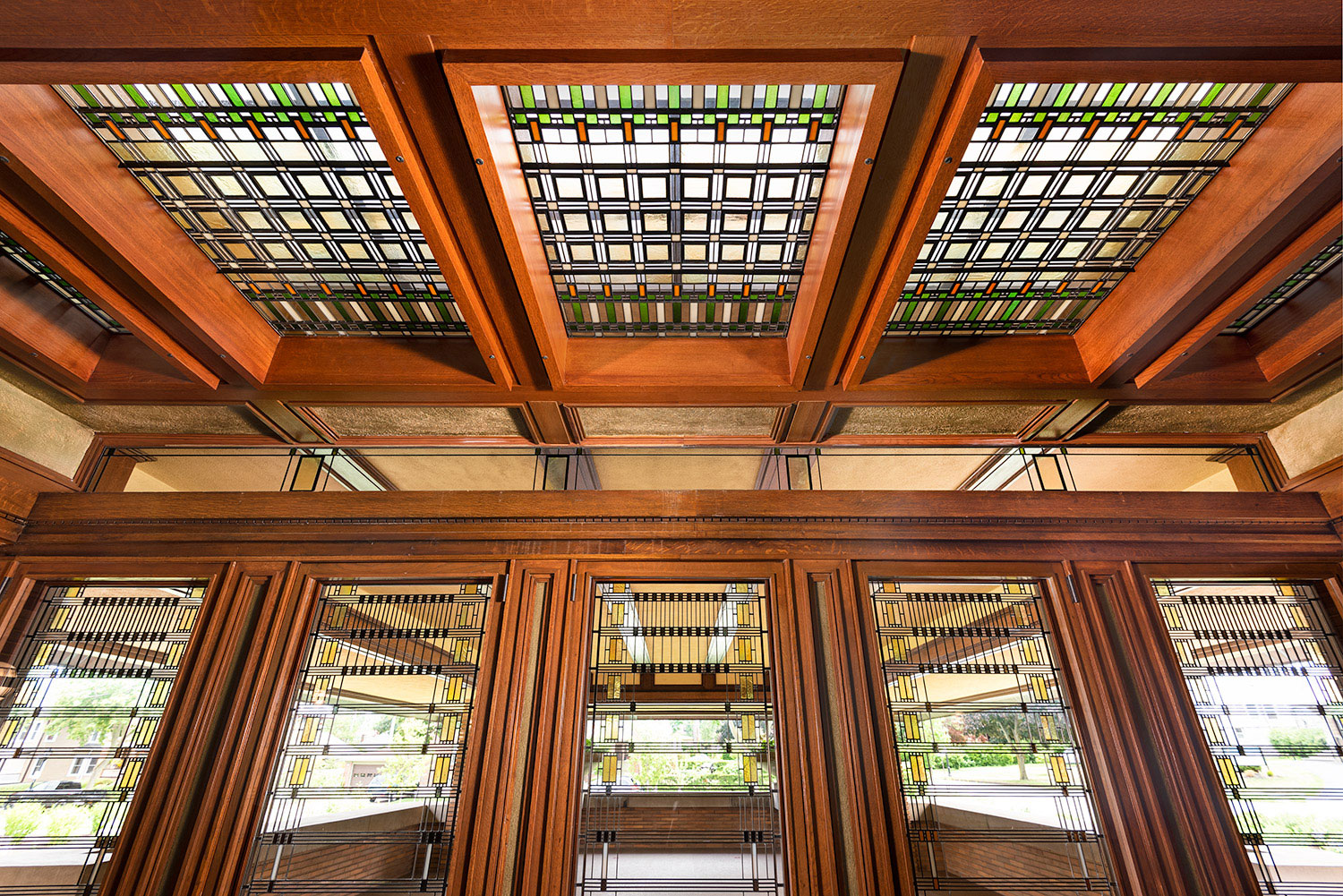A Canadian-American Museum Partnership in Celebration of the 150th Anniversaries of Canadian Confederation and Frank Lloyd Wright’s Birth
The University of Victoria (UVic) and the Martin House Restoration Corporation (Martin House) announce the historic transfer of seven original art glass panels from the University’s Legacy Art Galleries back to their original context in Frank Lloyd Wright’s Darwin D. Martin House.
Wright’s “light screens,” as the architect liked to call them, are an important contributing attribute to the overall significance of the Martin House. There are 16 site-specific patterns of art glass in the form of windows, doors, lay lights, and skylights, which were designed by Wright exclusively for the Martins for their multi-residential estate. In fact, the Martin House has more art glass in more patterns than any other house designed by Wright. Each pattern is stunningly beautiful and fundamental to understanding Wright’s revolutionary “total design” principles.
The seven light screens—which were removed from the Martin House during a period in the property’s history when the home remained vacant and fell under disrepair—were purchased by the University and have been under their professional care for nearly fifty years.
By making the bold decision to return these light screens back to the Martin House, the University of Victoria has asserted its leadership role as a steward of the public trust and reinforced its legacy as a center of cultural and artistic excellence.
“We are doing the “Wright” thing by reuniting these stunningly beautiful light screens within their original context,” says Director of UVic Legacy Art Galleries Mary Jo Hughes. “Because UVic recognized that Wright’s work can only fully be understood when seen as a unified whole, the light screens will go home this fall to Martin House, following five decades of careful stewardship by the university.”
This summer, the Legacy Art Galleries will host an exhibition, “So Long, Frank Lloyd Wright” (July 15-September 16, 2017), which will bring notice to the return process to the Martin House and allow the University community to say goodbye to the light screens. The transfer will officially go into effect in October 2017, at which time the panels will be permanently installed in the Martin House.
“The light screens represent a broad sampling of Wright’s genius in glass, which is critical to the scholarly interpretation and general appreciation of the complex,” stated Martin House executive director Mary Roberts.
The Martin House has had a long-held history of bi-national cooperation and friendship with our neighbors to the north. Through this extraordinary act of generosity and exchange, the University of Victoria and the Martin House mark two momentous occasions in our organizations history this year: the 150th anniversary of Canadian confederation (Canada 150) and the sesquicentennial of Frank Lloyd Wright’s birth (FLW 150).
Reflecting on this agreement, Canadian architecture icon Mme Phyllis Lambert said, “Architecture is an art, and the art glass defines the Martin House. The transfer of these seven original Wright-designed windows underscores the significance of experiencing architecture in context and leads to the public’s greater understanding of a contemporary masterpiece. As a defining component of the city of Buffalo’s renaissance, I am delighted to support the Martin House and this bi-national effort with the University of Victoria.”
About the Architect
Frank Lloyd Wright (American, 1867-1959)
Frank Lloyd Wright is internationally recognized as one of the most important figures in 20th century architecture and design. His genius is marked by his vision to create a new form of American architecture based on the open landscape of the Midwestern Prairie. Wright redefined traditional concepts of space by physically and spiritually connecting the built environment to the natural world. He is best known for his “Prairie style” homes, efficient office buildings, and innovative furniture and decorative designs.
About the University of Victoria
UVic is among the top-ranked universities in the world and offers life-changing, hands-on learning experiences to 21,000 students on the edge of the spectacular BC coast. As a hub of transformational research, UVic faculty and students make a difference on issues that matter to people, places and our planet. We have more research based on international collaboration than any other Canadian university and our community partnerships play a key role in generating vital impact, from scientific and business breakthroughs to achievements in culture and creativity. Find out more at uvic.ca.
About the Martin House Estate
The Martin House, designed and built from 1903-05, is considered by Wright scholars to be a significant turning point in the evolution of the Prairie house concept. The original complex consisted of the main Martin House, pergola, conservatory and carriage house, the Barton House and a gardener’s cottage, totaling nearly 32,000 square feet. Wright called the Martin House his “opus,” and had its plans tacked above his drafting board for decades. Reconstruction of the pergola, conservatory and carriage house was completed in early 2007 in the most ambitious restoration of demolished Wright buildings ever undertaken.
The Martin House Restoration Corporation is a New York not-for-profit corporation founded in 1992. It has a 30-member board of directors and approximately 400 active volunteers. The historic Martin House site is open for tours year round.









